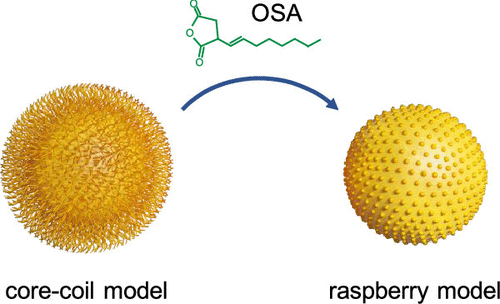当前位置:
X-MOL 学术
›
Biomacromolecules
›
论文详情
Our official English website, www.x-mol.net, welcomes your feedback! (Note: you will need to create a separate account there.)
Structure, Hydration, and Interactions of Native and Hydrophobically Modified Phytoglycogen Nanoparticles.
Biomacromolecules ( IF 6.2 ) Pub Date : 2020-08-21 , DOI: 10.1021/acs.biomac.0c00870 John Simmons 1 , Jonathan D Nickels 2 , Michelle Michalski 3 , Michael Grossutti 1 , Hurmiz Shamana 1 , Christopher B Stanley 4, 5 , Adrian L Schwan 3 , John Katsaras 4, 5 , John R Dutcher 1
Biomacromolecules ( IF 6.2 ) Pub Date : 2020-08-21 , DOI: 10.1021/acs.biomac.0c00870 John Simmons 1 , Jonathan D Nickels 2 , Michelle Michalski 3 , Michael Grossutti 1 , Hurmiz Shamana 1 , Christopher B Stanley 4, 5 , Adrian L Schwan 3 , John Katsaras 4, 5 , John R Dutcher 1
Affiliation

|
Phytoglycogen is a highly branched polymer of glucose produced as soft, compact nanoparticles by sweet corn. Properties such as softness, porosity, and mechanical integrity, combined with nontoxicity and biodegradability, make phytoglycogen nanoparticles ideal for applications involving the human body, ranging from skin moisturizing and rejuvenation agents in personal care formulations to functional therapeutics in biomedicine. To further broaden the range of applications, phytoglycogen nanoparticles can be chemically modified with hydrophobic species such as octenyl succinic anhydride (OSA). Here, we present a self-consistent model of the particle structure, water content, and degree of chemical modification of the particles, as well as the emergence of well-defined interparticle spacings in concentrated dispersions, based on small-angle neutron scattering (SANS) measurements of aqueous dispersions of native phytoglycogen nanoparticles and particles that were hydrophobically modified using octenyl succinic anhydride (OSA) in both its protiated (pOSA) and deuterated (dOSA) forms. Measurements on native particles with reduced polydispersity have allowed us to refine the particle morphology, which is well described by a hairy particle (core-chain) geometry with short chains decorating the surface of the particles. The isotopic variants of OSA-modified particles enhanced the scattering contrast for neutrons, revealing lightly modified hairy chains for small degrees of substitution (DS) of OSA, and a raspberry particle geometry for the largest DS value, where the OSA-modified hairy chains collapse to form small seeds on the surface of the particles. This refined model of native and OSA-modified phytoglycogen nanoparticles establishes a quantitative basis for the development of new applications of this promising sustainable nanotechnology.
中文翻译:

天然和疏水改性植物糖原纳米颗粒的结构,水合和相互作用。
植物糖原是葡萄糖的高度分支的聚合物,由甜玉米制成柔软,致密的纳米颗粒。诸如柔软性,孔隙率和机械完整性之类的特性,再加上无毒和可生物降解性,使植物糖原纳米颗粒非常适合人体应用,从个人护理配方中的皮肤保湿和嫩肤剂到生物医学中的功能性治疗剂不等。为了进一步拓宽应用范围,可以使用疏水性物质(例如辛烯基琥珀酸酐(OSA))对植物糖原纳米颗粒进行化学修饰。在这里,我们提出了颗粒结构,水含量和颗粒化学修饰程度以及浓缩分散液中明确定义的颗粒间间距的出现的自洽模型,基于小角度中子散射(SANS),对天然植物糖原纳米颗粒和使用辛烯基琥珀酸酐(OSA)进行了疏水化修饰的多聚形式(pOSA)和氘化(dOSA)的颗粒进行水分散体测量。对具有降低的多分散性的天然颗粒的测量使我们能够改进颗粒的形态,这可以通过毛状颗粒(核心链)几何结构以及短链装饰颗粒表面来很好地描述。OSA修饰的粒子的同位素变体增强了中子的散射对比度,揭示了OSA的小取代度(DS)的轻度修饰的毛状链,以及最大DS值的覆盆子粒子几何形状,其中OSA修饰的毛状链塌陷了在颗粒表面形成小种子。
更新日期:2020-10-12
中文翻译:

天然和疏水改性植物糖原纳米颗粒的结构,水合和相互作用。
植物糖原是葡萄糖的高度分支的聚合物,由甜玉米制成柔软,致密的纳米颗粒。诸如柔软性,孔隙率和机械完整性之类的特性,再加上无毒和可生物降解性,使植物糖原纳米颗粒非常适合人体应用,从个人护理配方中的皮肤保湿和嫩肤剂到生物医学中的功能性治疗剂不等。为了进一步拓宽应用范围,可以使用疏水性物质(例如辛烯基琥珀酸酐(OSA))对植物糖原纳米颗粒进行化学修饰。在这里,我们提出了颗粒结构,水含量和颗粒化学修饰程度以及浓缩分散液中明确定义的颗粒间间距的出现的自洽模型,基于小角度中子散射(SANS),对天然植物糖原纳米颗粒和使用辛烯基琥珀酸酐(OSA)进行了疏水化修饰的多聚形式(pOSA)和氘化(dOSA)的颗粒进行水分散体测量。对具有降低的多分散性的天然颗粒的测量使我们能够改进颗粒的形态,这可以通过毛状颗粒(核心链)几何结构以及短链装饰颗粒表面来很好地描述。OSA修饰的粒子的同位素变体增强了中子的散射对比度,揭示了OSA的小取代度(DS)的轻度修饰的毛状链,以及最大DS值的覆盆子粒子几何形状,其中OSA修饰的毛状链塌陷了在颗粒表面形成小种子。

























 京公网安备 11010802027423号
京公网安备 11010802027423号